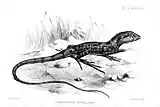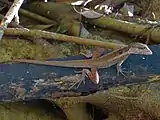Tropicagama
Tropicagama is a genus of large-bodied lizards in the family Agamidae. The genus is monotypic, with only one species listed: Tropicagama temporalis, commonly known as the swamplands lashtail or northern water dragon.[3] This semi-arboreal species inhabits the tropical savannah woodlands of northern Australia, as well as parts of New Guinea[2] and southeastern Indonesia.[4]
| Tropicagama | |
|---|---|
.jpg.webp) | |
| Scientific classification | |
| Kingdom: | Animalia |
| Phylum: | Chordata |
| Class: | Reptilia |
| Order: | Squamata |
| Suborder: | Iguania |
| Family: | Agamidae |
| Subfamily: | Amphibolurinae |
| Genus: | Tropicagama Melville et al., 2018 |
| Species: | T. temporalis |
| Binomial name | |
| Tropicagama temporalis (Günther, 1867) | |
| Synonyms[2] | |
| |
Taxonomy
From its original description in 1867 until 2017, genus Tropicagama has previously been included in multiple other genera, including Amphibolurus, Gemmatophora, Gowidon, Grammatophora, Lophognathus, and Physignathus. The new genus — Tropicagama — was created by Melville et al in 2018, after an extensive analysis of three genera (Amphibolurus, Gowidon and Lophognathus) that have had long-standing inconsistencies in their taxonomic classification. The morphological and mitochondrial DNA analysis revealed that four distinct evolutionary lines were lumped in the former genus Lophognathus. As a result, the former genus Lophognathus has now been split into genera Amphibolurus, Gowidon, Lophognathus, and Tropicagama. All of these genera are contained within subfamily Amphibolurinae.[2]
Phylogeny and biogeography

Sequencing and analysis of mitochondrial DNA, along with phylogenetic and divergence time analyses, reveals that the genus Tropicagama originated in the late Miocene and early Pliocene epoch.[5] T. temporalis migrated from Australia to New Guinea during the Pliocene epoch, sometime between 2.3 and 4.7 million years ago (Ma). It then migrated from New Guinea across Lydekker's Line into Wallacea less than 1 Ma, during the mid-Pleistocene epoch.[4] Wallacea is a zone of mixing between fauna of the Indomalayan and Australasian ecozones.[6] The eastern border of this zone is represented by a zoogeographical boundary known as Lydekker's Line, while the Wallace Line defines the western border.[7]
Description
T. temporalis is a slender agamid lizard of moderate size, with long limbs and a long and slender tail. The head is narrow and moderately elongated, with a short rounded snout and a prominent canthal ridge and tympanum. A broad white stripe extends from the tip of the snout, over the lower and upper lips, continuing below the tympanum and down the lateral portion of the body. This stripe tapers off at the hind legs, and it is intersected by three dark bands at the neck, shoulders, and upper back. The portions of the head above and below this stripe are a uniform dark gray or brown color. There is a prominent dorsal crest of enlarged keeled scales extending from the occiput to the shoulder. This crest continues as a ridge from the shoulder along the spine to the base of the tail. The front legs are darker in color and have more strongly keeled scales than the hind legs. A second, shorter white stripe sometimes extends from the posterior mandible to the area of the temporomandibular joint. The snout-to-vent length is 103 millimeters (4.1 in); hindlimb length is 87 millimeters (3.4 in).[2]
Distribution and habitat
T. temporalis is mainly found in the far northern Australian coastal regions in the Northern Territory and the western portion of the Cape York Peninsula. It also occurs in the southern part of New Guinea and on some of the islands to the north of Australia,[2] as far north as the Maluku Islands of Indonesia.[4]
Within its distribution, this semi-arboreal species can be found in a range of habitats, including coastal dunes, tropical savannah woodlands, monsoon forests, paperbark swamps and billabongs, creeks and riverine environments.[8] In particular, it can be found in the Arnhem Land tropical savanna, the Cape York Peninsula tropical savanna, the Carpentaria tropical savanna, the Trans-Fly savanna and grasslands, the Victoria Plains tropical savanna, and possibly the Kimberley tropical savanna.[1][2]
Gallery
 1883 illustration by Joseph Smit. The species was classified at that time as Lophognathus maculilabris
1883 illustration by Joseph Smit. The species was classified at that time as Lophognathus maculilabris.jpg.webp) Northern water dragon sitting on a weather station anemometer
Northern water dragon sitting on a weather station anemometer Northern water dragon at Fogg Dam Conservation Reserve, Northern Territory, Australia
Northern water dragon at Fogg Dam Conservation Reserve, Northern Territory, Australia
References
| Wikimedia Commons has media related to Tropicagama. |
- Oliver, P., Parker, F., O'Shea, M., Allison, A., Tallowin, O., Zichy-Woinarski, J., Wilson, S., Melville, J., Doughty, P. & Ellis, R. (2017). "Swamplands Lashtail (Lophognathus temporalis)". The IUCN Red List of Threatened Species. Gland, Switzerland: International Union for Conservation of Nature’s Red List of Threatened Species. ISSN 2307-8235. Retrieved 18 January 2021.CS1 maint: uses authors parameter (link)
- Melville, Jane; Ritchie, Euan G.; Chapple, Stephanie N.J.; Glor, Richard E.; Schulte, James A. (2018). "Diversity in Australia's tropical savannas: An integrative taxonomic revision of agamid lizards from the genera Amphibolurus and Lophognathus (Lacertilia: Agamidae)" (PDF). Memoirs of Museum Victoria. 77: 41–61. doi:10.24199/j.mmv.2018.77.04.
- Uetz, Peter; Hallermann, Jakob (2021). "Tropicagama temporalis (GÜNTHER, 1867)". Reptile Database. Retrieved 18 January 2021.
- Karin, Benjamin R.; Stubbs, Alexander L.; Arifin, Umilaela; Iskandar, Djoko T.; Arida, Evy; Austin, Christopher C.; McGuire, Jimmy A. (2020). "Crossing Lydekker's Line: Northern Water Dragons (Tropicagama temporalis) Colonized the Mollucan Islands of Indonesia from New Guinea". Herpetologica. 76 (3): 344–50. doi:10.1655/Herpetologica-D-19-00033. S2CID 221564902.
- Melville, J.; Ritchie, E.G.; Chapple, S.N.J.; Glor, R.E.; Schulte, J.A. (2011). "Evolutionary origins and diversification of dragon lizards in Australia's tropical savannas". Molecular Phylogenetics and Evolution. 58 (2): 257–70. doi:10.1016/j.ympev.2010.11.025. PMID 21145401.
- New, T.R. (2002). "Neuroptera of Wallacea: a transitional fauna between major geographical regions" (PDF). Acta Zoologica Academiae Scientiarum Hungaricae. 48 (2): 217–27.
- Kealy, Shimona; Louys, Julien; o'Connor, Sue (2015). "Islands under the sea: a review of early modern human dispersal routes and migration hypotheses through Wallacea". The Journal of Island and Coastal Archaeology. 11 (3): 364–84. doi:10.1080/15564894.2015.1119218. S2CID 129964987.
- Cogger, Harold G. (2014). "Family Agamidae (Dragon Lizards)". Reptiles and Amphibians of Australia (7 ed.). Collingwood, Victoria: CSIRO Publishing. p. 740. ISBN 978-0643100350.
